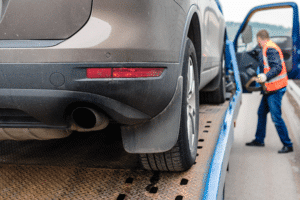Vehicle transport companies can find it difficult to provide very specific pickup and delivery times. Unforeseen problems like traffic or breakdowns can cause potential delays. Patience, preparation and communication with your vehicle transporter will help you both have a positive experience. Set a meeting point that you and your carrier can easily access. You may have to meet in a close-by parking lot if the streets in your residential area are hard to navigate by truck. If you can’t be there to release the vehicle into the transporter’s care, assign a trusted representative to handle things for you.
What To Expect When Your Vehicle is Picked Up
Before meeting your transporter, both you and your transporter should be completely clear about payment for the service. Confirm the terms of your contract, payment information, insurance terms, and mutual contact information. If you have any last-minute questions about the vehicle shipping service, ask your driver. Make sure your car is fully prepared for transit according to our preparation guidelines when your transporter arrives. This is also the time to remind the transporter of any mechanical issues previously discussed in the booking period, though it is advised that vehicles in transit do not leak or have mechanical problems. If this is not the case for you, make sure you have notified the transporter in advance so that they can make the preparations and give you an accurate price.
The transporter will conduct an inspection of your vehicle. Be prepared to review the driver’s Bill of Lading, which details their inspection of the vehicle. This document will be signed both at origin and destination.
Before your car is loaded on the trailer, note the odometer reading; though your car may be driven a little in order to load or store your vehicle, there should be no major mileage discrepancies when the car is delivered. Before the transporter leaves, notify them of any special notes instructions they may need to know.
What To Expect When Your Vehicle is Delivered
A big tip for having a smooth vehicle delivery is simply being on time to meet your transporter. Upon your vehicle’s arrival to the destination, conduct another inspection comparing the current state of your vehicles against your records. Having a record of the vehicle’s condition before and after transport will be helpful in the rare incident that it has been damaged. If you cannot conduct the inspection yourself, assign a trusted representative to inspect the vehicle on your behalf. If you are meeting the transporter at night, bring a flashlight so you can inspect the vehicle on site. Keep in mind that if you chose to use open transport, your vehicle will have traveled just as if you drove it yourself. It will face the same road debris, dust, rain, snow, etc. In addition to checking for cosmetic damages, look at the car’s undercarriage, check the odometer, and start up the car to check for mechanical problems.
Payment for the service is due upon delivery. Follow through with the agreement you worked out with your carrier. Upon completion of your inspection, you or your representative will be asked to sign a Bill of Lading, which makes the transaction final.
After the Vehicle Shipping Service
In the unlikely event that your car has been damaged while being transported, make sure a note has been made on the Bill of Lading prior to accepting the car. This is critical, as the delivery point is your only window of opportunity to inspect and report damages from transport. Follow your service provider’s instructions for filing a claim immediately. Make sure that the driver or transport company’s agent has signed your record of damages and try to file with your insurance within 24 hours.
For most shippers, once the car is delivered the shipping process is completed. If you have had a particularly positive experience with your vehicle shipping service, leave them a positive feedback score and comment on their uShip profile.




